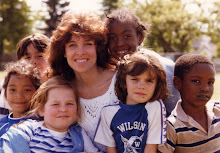A few moments ago I walked by a patch of flowers and the foxglove memory came back. Here's how it went.
Years ago, one of my colleagues created me a series of spring break till the end-of-the-school-year "advent" calendars. Each year she came up with a different scheme, and one particular year it was a series of flower pots with numbers on them. Day by day my students and I flipped up a numbered pot to find another pot with a wildflower picture pasted above, the flower name in calligraphy on the pot. The flower illustrations had originally been hand-painted by James Audubon. An intact set of pictures in book form was included for my first graders to browse and learn more. I decided to match each child with a wild flower and as that flower was revealed, the kids took on the role of helper for the day.
Trillium, primrose, goldenrod, forget-me-nots, phlox, anemone. Each day another flower, each day another new name to playfully roll off the kids' tongues and to match with a flower. Who knew how engaged urban first graders could be with wild flowers!
In mid-May I scheduled a field trip to Snake Lake, a local nature reserve. Our elderly docent handed out nature name tags (Canada goose, fir tree, wood duck ...) to the kids and we set out on our walk. We paused at each natural feature along the trail for her descriptions, and she would then invite the kids to "take 5 bunny hops" or to "tip toe behind Canada goose" to the next stop on the tour. (Ah ... I should have known she was a retired kindergarten teacher!)
"Does anyone know this plant?" she queried at one stop. Brandon stepped from behind another student to look more closely. "Is that foxglove?"
Imagine her amazement! And imagine my own. Then again, she asked rather than telling the name. That alone is significant. And we had been studying wildflowers by chance!
Even though I know how smart even the youngest kids are, I continue to be amazed by what catches their attention and sticks with them. This recognition has helped me reconsider the "what" of curriculum. Seven-year old Leslie wanted to learn more about famine. A 9 year old student of a colleague decided to study how property taxes are assessed, an interest that was precipitated by his father's irritation that their taxes had increased. Another first grader shared that the last small gas station in Redmond was closing. When a classmate responded, "So what--there are lots of gas stations," he clarified that this was a family-owned gas station! Without fail, I now always focus part of my time with kids on learning more about their keenest interests.
Language researcher, Gordon Wells, reminds us that all of us learn language from the company they keep. If you want someone to sound like a lawyer, invite them hang out with lawyers. Kids learn "vocabulary" as they use it to talk about new concepts, and to a much lesser degree, through memorizing words and their definitions. (If you would like to read more about any of this, let me know and I'll share resources.)
Is that foxglove? Indeed.
Subscribe to:
Post Comments (Atom)




No comments:
Post a Comment